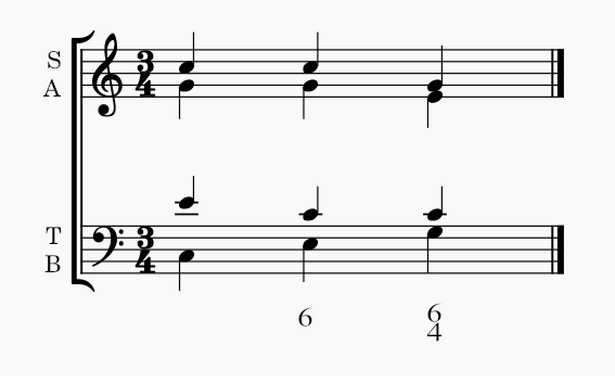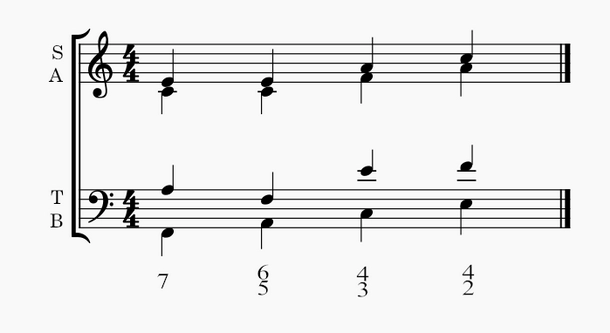An inversion represents a change to the intervals, voices, melodies, and chords. The figured bass notation is a way to represent the different inversions of the chords.
The current article on the figured bass symbols covers its music theory, the inversions of triads and 7th chords and their diatonic numbers, the figured bass symbols, the use of accidentals, holding the notes of the chords, and the figured bass chart.
Read the complete article to know about the figured bass notation in detail.
What is a Chord Inversion & Figured Bass Symbol?
If you rearrange the notes of any chord so that its original root note does not remain in the bass position, you have created an inversion of the chord. This applies to any type and structure of the chord. The original chord with the root in the bass position is known as the parent chord or the root position chord.
A chord with n notes can have (n-1) inversions. Each inversion has a different bass note in the increasing order of the pitches. In tertian harmony, the first inversion has 3rd as the bass, and the second inversion has 5th as the bass, and so on.
The chord inversions are notated by a slash chord or by figured bass numbers. The figured bass is a musical notation system, also known as thoroughbass. It uses numbers or symbols above or below the bass note to indicate intervals, chords, and non-chord tones.
The other systems in use are plain notation on staff (in classical music), Roman numeral (in harmonic analysis), Nashville number system, chord letters, and chord names or lead sheet symbols used in popular music and jazz.
Figured Bass Music Theory
You had seen the music theory behind the triads in inversion, the inverted seventh chords, and the new intervals created by them in our separate article on Chord Inversion. These intervals are summarized in the upcoming sections.
Intervals of a Triad & Its Inversions
The intervals between the bass note, the second, and the third notes of the root position triads, their 1st, and 2nd inversions are as follows:
| Intervals from Bass | Major Triad | Minor Triad | Diminished Triad |
|---|---|---|---|
| Root Position Triad | M3 & P5 | m3 & P5 | m3 & d5 |
| First Inversion Triad | m3 & m6 | M3 & M6 | m3 & M6 |
| Second Inversion Triad | P4 & M6 | P4 & m6 | A4 & M6 |
Closely observe the intervals of the inversions. You will note that in all types of root position triads, the intervals from the bass notes have the diatonic numbers 3 and 5, even though the name or quality of the intervals vary between Major, minor, Perfect, and diminished. The diatonic numbers are the scale steps above the given bass lines that the current chord is in.
In C, 3 and 5 mean E and G, respectively.
In a similar way, the intervals above the bass of any triad in the first inversion are 3 and 6 only. Following the same pattern, the second inversion triads have 4 and 6, with changing qualities. To summarize, the diatonic numbers of intervals above the bass of the different inversions of the triads in the order from the higher to lower pitches are.
- Root Position – 5 and 3.
- 1st Inversion – 6 and 3.
- 2nd Inversion – 6 and 4.
As an example, the below diagram shows the inversions of the C major chord with the diatonic numbers.

The Intervals of a Seventh Chord & Its Inversions
The intervals between the bass note, the second, the third, and the fourth notes of the root position 7th chords, their 1st, 2nd, and 3rd inversions are as follows:
| Intervals from Bass | Major 7th | Minor 7th | Dominant 7th | Half Dim 7th |
|---|---|---|---|---|
| Root Position | M3, P5 & M7 | m3, P5 & m7 | M3, P5 & m7 | m3, d5, & m7 |
| 1st Inversion | m3, P5 & m6 | M3, P5 & M6 | m3, d5 & m6 | m3, P5 & M6 |
| 2nd Inversion | M3, P4 & M6 | m3, P4 & m6 | m3, P4 & M6 | M3, P4 & M6 |
| 3rd Inversion | m2, P4 & m6 | M2, P4 & M6 | M2, A4 & M6 | M2, P4 & m6 |
You can note a similar pattern in the triads and seventh chords in relation to the diatonic numbers. You will note that in the 7th chords also, these numbers remain constant for a particular inversion. These are summarized below for the 7th chords.
- Root Position – 7, 5, and 3.
- 1st Inversion – 6, 5, and 3.
- 2nd Inversion – 6, 4, and 3.
- 3rd Inversion – 6, 4, and 2.
As an example, the below diagram shows all the inversions of the 7th F major chord with the diatonic numbers.

Figured Bass Symbols
A bass line carries its notes on the bass clef of the musical staff. A notated bass line has some additional numbers and accidentals beneath the bass staff lines. These numbers indicate the intervals above the bass note that you should play. They indirectly represent the inversions of the chords for you.
As stated earlier, the figured bass is a notation system by which you can indicate the chord inversions through Arabic numerals, also known as the figures. The figures are placed either above or below the bass note or both. As you would have guessed, these numbers represent the intervals from the bass note.
The figured bass realization bears no relation with the key signature, the way Roman numeral analysis does. It neither reveals any information about the intervals between the upper voices nor does it tell if any other voice carries the same note as the bass voice.
Figured Bass Notation for Triads
You have seen that the root position triads have 5 and 3 as their diatonic numbers, which are related to the fifth and a third of the chord. Hence, a C major chord in root inversion in the figured bass system is denoted as C5⁄3. However, as a convention, the root position triads are notated without the 5⁄3 chord symbol, which is implied or understood.
The diatonic numbers 6 and 3 represent the intervals of the first inversion. Hence the C major triad in its 1st inversion has the following figured bass representation – C6⁄3. In the simplified form, this inversion is just notated as C6.
Similarly, the 2nd inversion has 6 and 4 diatonic numbers, and chord voicings in the 2nd inversion are denoted by a chord symbol – C6⁄4. The term “6” and “6⁄4” chords are frequently used to denote the first and second inversions of the triads.
While their initial use was with the bass notes, the representation is now used in conjunction with the Roman numerals to denote the scale degree of the root of the parent chord and its inversion. For example, V, V6, and V6⁄4 represent the three inversions of the Dominant V chord, built on the scale degree 5 or a major or natural minor scale.
Similarly, the inversions of the tonic chord are notated as I, I6, and I6⁄4.
The harmonic progressions also use this notation to specify the inversions of various chords, like I – V6⁄4 – I6 or ii6 – I6⁄4 – V – I.
Figured Bass Chord Symbols for Seventh Chords
The figured bass naming system for the 7th chords follows the same logic as the triads. What you need to remember is the numbers used in the shorthand or the simplified forms. These are summarized below.
The Root Position Chord – It has the diatonic numbers 7, 5, and 3, out of which 5 and 3 are the same same as those of the root positions of a basic triad. These two numbers are implied, and only 7 represents the root inversion. For example I7, V7or ii7.
The First Inversion: The diatonic numbers are 6, 5, and 3. The 7 is ignored in the rest of the inversions. So the chosen representation is 6⁄5. Hence the first inversion 7th chords are notated as I6⁄5, V6⁄5, etc.
The Second Inversion: The diatonic numbers are 6, 4, and 3. The chosen representation is 4⁄3. Here 6 is ignored as it is used in triads in 1st and 2nd inversions. Hence the second inversion 7th chords are notated as I4⁄3, V4⁄3, etc.
The Third Inversion: The diatonic numbers are 6, 4, and 2. So the chosen representation is 4⁄2. Hence the third inversion 7th chords are notated as I4⁄2, V4⁄2, etc. Please note that if only 2 is mentioned in the figure, it represents the 3rd inversion of a 7th chord.
Holding of Notes
Sometimes the lowest note is held, but the other notes of the chord change. You need to indicate the revised intervals on the bar for the new chord. The reverse can also happen, whereby the bass note moves while the balance notes are held.
In such a case, a line is drawn next to the figure after the note, and the upper notes are held. You need not mention the revised intervals due to the movement of the bass till the upper notes move again.
Use of Accidentals
The following rules apply if you spot any accidental with or without a figure:
- If the accidental is without any number of figures, it normally applies to the third above the bass. In most cases, this should be the 3rd of the chord. If the accidental is a sharp, you must raise the 3rd by a half step. If it is a flat symbol, you should lower the third by a semitone. These accidentals may be used to carry out the chromatic alterations in the chord.
- If any number is shown, the accidentals will apply to that interval above the bass. For example, if the symbol is b6, it means the note at the 6th interval should be lowered by a semitone. The accidental can be written after the figure also.
- A composer may use a symbol of cross (+) before the figure or a backslash through the figure to indicate the raising of the pitch by a semitone.
- The forward slash through the figure number directs the player to lower the pitch by a semitone.
- The symbols may be used to cancel or negate an opposite symbol in the key signature.
Figured Bass Chart
The below table represents the figured bass chart for the triads and the 7th chords for your ready reference.
Conclusion
We hope that the article on the Figured Bass Notations has been helpful to you and supplied you with the information you were looking for. Please comment in the section below and like or share if you really liked it.
